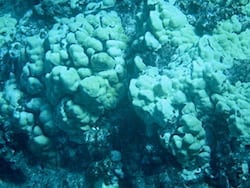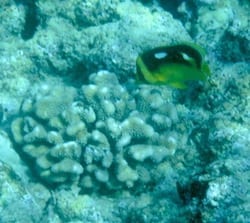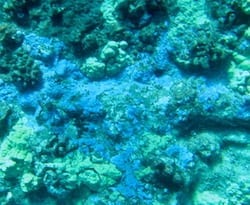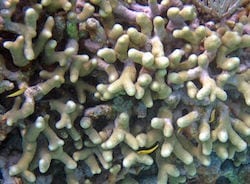When driving to Hana and following directions, it's all about the mile markers. For most of us, mile markers are nearly always looked over. For this trip, though, keep an eye out for them!
Before you begin your trip, make sure you check out our What to Pack Guide to make sure you bring everything you'll need for a successful journey.
Starting from Paia...
Twin Falls (Mile marker 2)
We know some people don't stop here because it feels like the trip just started. Because it's so close to Paia, it's the single most crowded destination on the trip. But it's well worth battling the crowds. The falls are gorgeous and less than a mile from the highway. There is also outstanding hiking beyond the falls. If you decide to drive past it, we highly recommend you visit it another day. Or, if you're doing an out-and-back to Hana, hit it on your return. Afternoons are far less crowded. You can also pick up fruit and drinks at the Twin Falls Farm Stand.
Waikamoi Nature Trail (Midway between mile markers 9 and 10)
A quick hike, but we enjoy it. It takes you through an old forest with plenty of greenery and some scenic views. It's not spectacular, but it's a nice stop to stretch your legs.
Garden of Eden (Midway between mile markers 10 and 11)
You will probably pull in, see that they charge $15 per adult, and get back on the road. But, if you have the means, the Garden of Eden is really pretty spectacular. A little earlier this year, we named it the best tropical garden on Maui. For the price of admission, you will see 26 acres of lush greenery and every tropical flower you can imagine. You'll also see where they shot the opening sequence of "Jurassic Park" and take in some of the best views of Puohokamoa Falls.
Ke'anae Arboretum (Just past midway between mile markers 16 and 17)
A smallish, six acre, state-owned arboretum that provides free walking trails through a well maintained nature park. This is an excellent place to get out of the car and stretch your legs if you haven't stopped anywhere yet on your trip. There are about 150 specimens of trees, each well marked. Included amongst these trees are numerous fruit trees you won't find anywhere but Hawai'i.
Ching's Pond (Just before mile marker 17)
This is a quick one. Ching's Pond (AKA Blue Sapphire Pools) is a small swimming hole popular amongst locals. The brave (or maybe it's the foolhardy) will make the 25-foot cliff leap. If you decide to jump, research it first. There's a target you need to aim for or you'll be crushed.
Wailua Valley State Wayside (Just past the halfway point between mile marker 18 and 19)
Another quick stop, just take the small set of stairs on the right and you'll be awarded with some amazing views of the Ke'anae Valley, Wailua Village and the ocean. On a clear day, you can even see waterfalls. You can't get the view from inside your car, so definitely get out and stretch your legs if you stop here.
Upper Waikani Falls (Just past midway between mile markers 19 and 20)
Many people snap photos of this waterfall (AKA Three Bears) from the car. But, if you want to stop, continue driving less than a quarter mile and you'll find parking. It's a short hike down to the falls, and most of the year, it's a comfortable swimming hole.
Kahanu Garden (Just past mile marker 31)
This spectacular 294-acre tropical botanical garden is another of our favorite tropical gardens on Maui. There's a $10 fee for adults, children under 12 are free. For your admission fee, you will see plants, trees and flowers from the Pacific Islands, as well as National Historic Landmark, Pi'ilanihale Heiau, a massive lava rock structure, and the largest ancient place of worship in Polynesia.
Waianapanapa State Park (Mile marker 32)
With its black sand beaches, views, blowhole, hiking and caves, Waianapanapa is always a favorite stop. Most people park, quickly snap a photo, and get on their way. But, if you decide to walk down to the beach, you're in for a treat. The black sand feels nice running between your toes and there's small cave just as you enter the beach that provides excellent Instagram opportunities. Because people are in such a hurry, though the parking may appear full, it tends to have a steady flow of people leaving. We highly recommend spending an hour or two exploring.
Kaihalulu Red Sand Beach (In Hana Town, trail begins just past the Travaasa Hotel)
While it's somewhat difficult to get down to the beach due to a crumbling trail (the drop is steep), if you decide to go for it, the red sand beaches are a memory you won't soon forget. That said, if you're somewhat squeamish about heights, or you have little ones with you, we don't recommend this stop. Because of the inherent dangers, the beach itself is fairly empty. If you do see anyone here, chances are they will be naked as this is a clothing optional beach.
Wailua Falls (Mile marker 45. FYI, the mile markers go in reverse from Hana, counting down from 51)
You can see these 80-foot falls from the side of road, where there is plenty of parking and usually a street vendor or two. It's an easy hike down to the water and most people do Wailua Falls from the road, so if you have the time, we definitely recommend heading down and maybe even going for a quick swim. Due to its beauty and roadside location, it's the most photographed waterfall on Maui.
Seven Sacred Pools and the Pipiwai Trail (Mile marker 42)
Generally the last stop on a one-day excursion to Hana, Seven Sacred Pools (Ohe'o Gulch) often times gets skipped because people run out of time. The easiest way to get to see the pools is to pay to enter Haleakala State Park. If you time a Hana trip on back-to-back days to the summit to see the sunrise, you can use the same receipt to get in. Once parked, there's a short .5 mile hiking loop to see the pools. Depending on the time of year, you'll be able to enter the pools for quick dip. Regardless of whether you're allowed to swim, the pools are beautiful. The other thing to do at this stop is to hike the Pipiwai Trail, a well-maintained, 2-mile trail that leads you to the 400-foot Waimoku Falls. Before reaching the falls, you'll see a massive banyan tree and walk through a lush, bamboo forest. It's absolutely gorgeous, and our single favorite location on the entire trip. Don't miss this!
Finally, if your car is up for it, we recommend driving around the backside of Haleakala, rather than circling back and returning to the Road to Hana. The road get narrow and, in fact, there is no road in parts of it, but the trails are well-driven, so you don't need an SUV. The backside is mostly all driving with very few stops, but the desert-like terrain and the lava fields are beautiful and a nice change of pace from the jungle you just drove through. You'll end up in Kula, near the winery if you could use a calming drink after 10 hours on the road. This is where you should change drivers, as the person who drove this far deserves a break!
PRO TIP: Start at the aforementioned "back way" to get to Hana. Going in the reverse direction, you'll hit the best parts of the trip, before they become crowded later in the day, then you'll hit spots like Twin Falls after everyone else has already left. Rarely do people do the Road to Hana in this direction.
Hana Day Trip Planning Guide: What to Pack
Hana Day Trip Planning Guide: Where to eat
 Lobe Coral
Lobe Coral Cauliflower Coral
Cauliflower Coral Rice Coral
Rice Coral Finger coral
Finger coral